![]()
![]()
![]()
Use LEFT and RIGHT arrow keys to navigate between flashcards;
Use UP and DOWN arrow keys to flip the card;
H to show hint;
A reads text to speech;
76 Cards in this Set
- Front
- Back
- 3rd side (hint)
|
intrapleural pressure |
later |
|
|
|
Upper respiratory System |

|
|
|
|
Lower respiratory system |

|
|
|
|
Respiratory System Functions |
•Exchange of gases between the atmosphere and the blood •Homeostatic regulation of body pH •Protection from inhaled pathogens and irritating substances (IGA, the antibodies that are in mucus) •Vocalization •Conditions air -Warming air to body temperature -Adding water vapor -Filtering out foreign material (cilia trap and get rid of pathogens) |
|
|
|
External respiration hpic (2 circulation series, one for using oxygenated blood, one for moving the blood back to heart) |
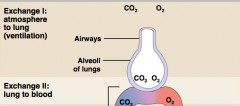
|

|
|
|
Epithelial Cells hpic |

|

|
|
|
Branching of airways |
as divisions increase... -Diameter gets smaller - number of airpockets increase exponentially -Cross sectional area increases exponentially (more air can be held) |
|
|
|
Alveoli hpic |
80-90% of alveoli covered in capilaries covered in bedding of blood, needs a way to get in touch with blood to oxygenate it. |

|
|
|
Rat vs Frog |
Rat has more Surface Area for Alveoli (more SA = more diffusion) Frogs=cold blooded, metabolism slows down, and oxygen need decreases. can breath through skin, so SA of lungs evened out Rats are warmblooded, need oxygen all the time in order to stay that temp |
|
|
|
Pulmonary Edema (fluid increase in interstitial space) |
•An increase in capillary permeability->intercellular clefts widen •Albumin leaks from the capillaries •Increase in interstitial protein osmotic pressure draws water into the interstitium •However, the interstitial space is small •Fluid spills into the alveoli, interfering with diffusion and exchange |
|
|
|
The pleural Sac (hpic) |
The pleural sac forms a double membrane surrounding the lung, similar to a fluid-filled balloon surrounding an air-filled balloon. |
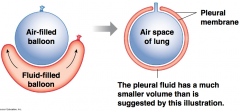
|
|
|
Air in the Lungs |

|
|
|
|
surface tension |
the interface between water and air. for the lungs its known as the Law of LaPlace. (the difference in wall tension in different parts of the lung) |
|
|
|
Complience hpic |
-The change in pressure needed to inflate the lungs to a particular volume, essentially, the ability ot stretch. high compliance: stretches easily, requires a lower pressure change to inflate lungs. if its too compliant, then its a disease that kills tissue. low compliance: requires more force, stiff, requires a larger pressure change to inflate the lungs to the same extent as compliant lungs. Fibrosis(lungs have scar tissue) |

Palv= alveolar pressure Pip= interplueral pressure |
|
|
Elastance |
The ability to return to resting volume when stretching force is released. |
|
|
|
Compliance has two aspects hnotes |
•Characteristics of the tissue -Compromise of the rib cage (broken rib/muscles) -Scaring of lung tissue (fibrosis) -Swelling and inflammation (edema) -pneumothorax (air in interpleural space, and lungs collapse) •Surface tension -Lack of surfactant |
emphysema: high compliance, low elasticity (can breath in easily, but cannot force air out) |
|
|
Surface tension |
•Allows water particles to stick together–like beading of water on a slick window •High surface tension makes alveoli more likely to collapse. •Different sized alveoli have different collapsing pressures with equal ST •Surfactant lowers ST and lowers it more in the small alveoli so that pressures are equal |
|
|
|
Law of LaPlace (if Surface tension is same, then smaller bubble has higher pressure) hpic more surfactant = less surface tension= equalize of pressures |
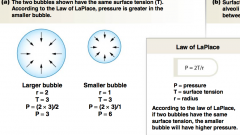
|

|
|
|
Surfactant |
•More concentrated in smaller alveoli •Mixture containing proteins and phospholipids •Newborn respiratory distress syndrome -Premature babies -Inadequate surfactant concentrations |
|
|
|
Airway Resistance |
•Single respiratory cycle consists of one inspiration followed by one expiration •Airway resistance influenced by the same principles as vascular resistance •Flow∝∆P/R <-- WHAT LAW IS THIS? (Ohm's law) •Most important influence on the airways is the radius of the airways •In Asthma and COPD, airway resistance is pathologically high. (chronic obstructive pulmonary disease, like emphysema) |

|
|
|
Local control of blood flow |
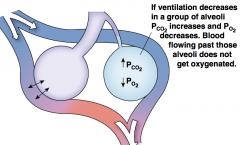
Vasodilation decreases resistance, increases bloodflow to that area |

Hypoxic vasoconstriction. Local control mechanisms try to Keep ventilation and perfusion matched |
|
|
Hypoxic vasoconstriction |
•Local responses in the lung are different! •Low oxygen in the airways causes the blood vessels going to that part of the lung to constrict. •Why is this helpful? (diverts path from poor alveoli to a good one, maximizes oxygenation) •How could it be harmful? If you have hypoxia everywhere, vasoconstriction occurs, then pressure goes up. afterload in ventricle increases |
|
|
|
Vital capacity |
•Total amount of air that can be moved in and out of the lungs •3.5 to 4.5 liters •Reduced with any kind of pulmonary disease |

|
|
|
%FEV1 |
•Measure of airway resistance •Volume of forced expiration in one sec divided by forced vital capacity •FEV1/FVC •3 liters/4 liters = 75% •70-80% normal •Decreased with obstructive disease like asthma or COPD *does not show for restrictive diseases. |
|
|
|
restrictive vs obstructive |
•Restrictive •Low compliance or stiff lungs •Small tidal volume with high RR •Fibrosis, tuberculosis, interstitial lung disease, ARDS, pulmonary edema |
•Obstructive •High airway resistance •Must be taught to take large TV with a low RR (called pursed lip breathing) •Asthma, emphysema, chronic bronchitis |
|
|
Commonalities |
•Both would have a reduced vital capacity -R–difficulty expanding to get air in -O–difficulty recoiling to get the air out •Both would have a reduced flow rate -See explanations above •Both would have an increased work of breathing (WOB) |
|
|
|
Saturation vs oxygen |
saturation only applies to CO2 content, Oxygen content = both CO2 and O2 and also hemoglobin as well. |
|
|
|
Dalton’s Law (hnotes) |

|
normal atmosphere has around 20% O2, CO2 is only .03% therefore of that 760 torr, 20% of that comes from O2. |
|
|
oxygen pathway in pulmonary and systematic circulation |

|
|
|
|
Movement of Gases hpic |
•Pressure gradient (aka: concentration gradient) •Solubility •Temperature |

|
|
|
What if we didnt have hemoglobin? |
our cardiac output would have to be 67 liters/min to maintain tissue life. *its normally just 5 liters/min, even at highest exercise 20-25liters/min Hemoglobin carries a truckload of oxygen in our blood |
|
|
|
Oxyhemoglobin saturation curve hnotes |
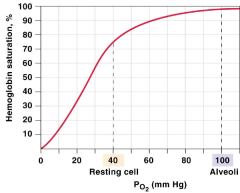
|
at 40% PO2, saturtaion still at 75,
but between 20-40% PO2, changes the shape of hemoglobin, and becomes a releaser of oxygen rather than a binder of oxygen (the normal PO2 found in capillaries) |
|
|
Alveolar gas exchange hnotes |

|

|
|
|
amount of oxygen bound to Hb hnotes |

|
Oxygen cannot be calculated unless you know exactly how much hemoglobin you have. |
|
|
Normal blood values for medicine hnotes |

|
the capilaries have a PO2 between 20-40 mm Hg |
|
|
Effect of pH on hemoglobin saturation (bohr effect) hnotes |

|
note: more acidic means easier to release oxygen from hemoglobin. high CO2, means more acidic right shift, and vice versa |
|
|
Effect of Temp on hemoglobin saturation |

|
|
|
|
Effect of PCO2 on hemoglobin saturation |

|
|
|
|
Total arterial O2 content hpic |

|

|
|
|
Carbon Monoxide |
•240 times the affinity for Hb than O2 •Decreases content with normal arterial Blood gases (ABGs) •NO SHORTNESS OF BREATH •Left shift (more basic, latched, harder to release oxygen from hemoglobin) |
|
|
|
Carbon Dioxide Transport |
•Dissolved: 7% •Converted to bicarbonate ion: 70% •Bound to hemoglobin: 23% –Hemoglobin also binds H+ –Hb and CO2: carbaminohemoglobin •CO2 + H20 -> H2CO3 -> H+ + HCO3- •NOTE: a build up of CO2 causes a build up of acid |
|
|
|
Carbon dioxide transport hpic |

|

|
|
|
What have you learned about content and saturation? |
•Mary has 12 gm% of hemoglobin and Frank has 13gm% •At a pO2 of 100 mmHg of mercury –who is more saturated? -who has a higher content? Who has higher dissolved content? Bound content? •What about at a pO2 of 60 mmHg? |
frank higher content both have same dissolved content and same saturation bound content is hemoglobin dependant |
|
|
reflex control of ventilation |
medulla oblongata and pons have pacemaker like functions pons: deepness of breath and rapidity. |
|
|
|
Regulation of Ventilation |
•Peripheral chemoreceptors –Located in carotid and aortic arteries –Sense changes in PO2 , pH, and PCO2 –Specialized glomus cells respond to low PO2 when drops to 60 mmHg or less •Central chemoreceptors –Respond to changes in CO2 |
|
|
|
chemoreceptors 2,3 DPG |
respond to one thing, 2,3 DPG signifies that glycolysis is occuring. |
|
|
|
Protective Reflexes Guard the Lungs |
•Respond to physical injury or irritation •Bronchoconstriction –Irritant receptors in airway mucosa send signals through sensory neurons •Sneezing •Coughing •Hering-Breuer inflation reflex -these are stretch receptors that are responsible for inflation reflex -if lungs are not stretched, causes inspiration, otherwise if too stretched, expiration |
Which of the following stimuli would most likely to cause BOTH the central and peripheral chemoreceptors to stimulate ventilation? –Arterial blood pH of 7.3. –PaCO2 of 44 mmHg. –PaO2 of 105 mmHg. –PvCO2 of 48 mmHg |
|
|
uhoh
|
increases as temp, CO2, (2,3 DPG), and H-ions increases(pH goes down)
and decreases in the vice versa scenario. as the graphs move to the right, metabolism is increasing because oxygen is being released from hemoglobin more easily |
|
|
|
lung facts |
dissolved CO2 goes into the alveoli oxygen binds to hemoglobin, hemoglobin goes up. normal atm = 79% N2, 20% O2, 1% random |
|
|
|
fatigue and oxygen |
if brain has so litle oxygen, will start changing saturation release factors. O2 and CO2 have to dissolve into blood to exhibit PO2 and PCO2. losing hemoglobin doesnt mean PCO2 increases. PCO2 affects hemoglobin, but hemoglobin does not effect PCO2
|
|
|
|
Hormones: Definition and Function |
•A chemical signaler secreted into the blood or interstitial fluid by one cell or group of cells and has a physiologic control effect through a specific receptor. •Examples of physiologic control effects –Affecting rates of enzymatic reactions –Transport of ions or molecules across cell membranes –Changes in gene expression and protein synthesis |
|
|
|
Important characteristics of hormones |
•Potent in small concentrations –amplification •Regulate biologic functions •Work through receptors that are specific for certain classes of hormones –Example estrogen receptors bind estrogens like estradiol, estriol or estrone |
|
|
|
Hormones: Classification by Chemical Class |
•Peptide or protein hormones •Steroid hormones •Amino acid –derived or amine hormones –Catecholamine = characteristics in common with peptides –Thyroidhormone = characteristics in common with steroids |
|
|
|
Hormones: Peptides or Proteins |
•Preprohormone (the gene is a lot bigger than the active peptide) –Large, inactive precursor •Prohormone –Smaller, inactive –Proteolytic, post-translational modification •Peptide/protein/glycoproteinshormones –Biologically active ( activate the hormone requires modification by changing the peptide, or adding the other stuff) |
|
|
|
Preprohormones |

|
|
|
|
Prohormones |

|
|
|
|
Peptides/Proteins/Glycoprotein |
•Large protein molecules which dissolve well in blood (water soluble) •Broken down quickly by peripheral enzyme systems (topic of research) (they disappear quickly) –Ex: chemical half life of GH 20 -30 minutes –Ex: chemical half life of epinephrine 2 minutes •Bind surface membrane receptors •Cellular response through signal transduction system –Most commonly second messenger systems –Can affect gene transcription |
|
|
|
Peptide hormone synthesis and processing (hpic) |
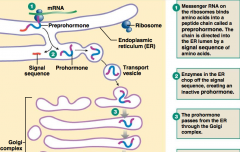
|

|
|
|
Hormones: Steroid hnotes |
•Cholesterol-derived –Lipophilic and easily diffuse cross membranes •Bind carrier proteins in blood (shields from degradation) –Longer half-life •Cytoplasmic or nuclear receptors –Genomic effect to activate or repress genes for protein synthesis –Slower acting •Cell membrane receptors –Nongenomic responses |
why are steroids slow acting long lasting? |
|
|
Steroids synthesis process |

|
|
|
|
Steroid transport |
•Because lipid soluble, must have a protein carrier, like a blood reservoir of steroid •Some carriers are specific –androgen binding globulin •Some carriers are general –albumin •Free hormone is biologically active |
|
|
|
Sex determination |
•Sex organs –Gonads contain germ cells and produce gametes and sex hormones –Male gonads->testes->sperm –Female gonads->ovaries->eggs –Internal genitalia –External genitalia •Nucleated cells contain 46 chromosomes –22 pairs of autosomes –1 pair of sex chromosomes |
|
|
|
Embryology hpic |
•Sex is genetically determined (XX vs XY) •Reproductive system starts out undifferentiated (in early fetal development, cant determine sex) •Y chromosome contains SRY gene ->testes and testosterone production ->differentiation of male structures (mutations in this gene can cause ambiguous child gender) •In absence of SRY->female structures |

|
|
|
Male structures hpic |
•Testes produce sperm and testosterone •Pathway –Seminiferous tubules (sperm made here) –Epididymis (sperm are stored here) –Vas Deferens (tube takes sperm out) –Ejaculatory duct (where the sperm leaves testes around bladder) –Glands (seminal vesicles, prostate, Cowper’s glands) –Urethra (tube down shaft of penis) –Penis (the name for said tube) |

|
|
|
More male structures hpic |

|

|
|

Testes and sperm hpic |
The testes contain: Seminiferous tubules in which all levels of spermatogenesis is found. Developing cells are protected by Sertoli cells. The interstitial Leydig cells are source of testosterone production |

|
|
|
hormonal control of spermatogenesis hnotes |

|
Spermatogonium: stem cells, are able to go through mitosis. sperm can bypass the blood bypass barrier L path goes through testosterone. SFH to testes, activates sertoli cells, make sperm. LH goes to leydig cells, makes testosterone and transports everywhere. testosterone feedbacks to the anterior pituitary and GnRH |
|
|
Puberty |
•As boy ages–brain seems to notice the lack of sex hormone •Role for Kisspeptin in puberty (helps brain sensitization to testosterone levels) •Increased GnRH -> LH ->testosterone (GnRH is secreted in pulses, depending on which hormone is needed) •Development of male organs •First sign of puberty is growth of the testicles (then the penis) •Testosterone accelerates growth –sealing of epiphyseal plate ->adult height |
SRH and testosterone are in synergy with each other |
|
|
Androgens Influence Secondary Sexual Characteristics |
•Primary sex characteristics are internal organs and external genitalia that distinguish males from females •Secondary sex characteristics are other traits that distinguish males from females –Body shape –Beard and body hair –Muscular development –Lowering of voice –Libido •Anabo ]lic steroids are used illegally by athletes |
if decreased anterior pituitary gland function causes decreased sperm and testosterone, will injecting testosterone make more sperm? no, need other hormones too. |
|
|
Pelvis cross section (not important) |

|
all external female genitalia = vulva |
|
|
Embryology |
•In female fetus –stem cells called oogonia undergo mitotic division •At birth 2-4 million oocytes in ovaries •About 400 may be ovulated over lifespan •Traditional view–all stem cells(oogonia) enter meiosis and stop, no remaining stem cells in ovary •New challenges to this way of thinking |
|
|
|
The Ovary Produces Eggs |
•Primary follicle –Primary oocyte –Granulosa cells produce estrogens –Theca cells produce androgen precursor used by granulosa cells (2step process to making estrogen. theca cells require requires granulosa cells as precurser) estrodial=main form of estrogen, made by granulosa cells |
|
|
|
Ovarian events hnotes |
•Under the influence of FSH, a few(12?) ovarian follicles containing primary oocytes develop •Follicular cells produce estrogens •Tertiary/Dominant follicle is chosen about day 7 •Ovulation occurs about day 14 of a 28 day cycle* •Follicle remnant->corpus luteum •Corpus luteum lasts about 14 days |
Lutenizing hormone ruptures the follicle for ovulation and turns it into a corpus luteum. |
|
|
Cycles are Variable |
•Important to note that cycles are variable... ovulation occurs about 14 days from the end of the cycle.. •In other words.. Variability is in the follicular phase. •Many women do not have a 28 day cycle |
|
|
|
Two cell process to make estrogen from androgen |

|
|
|
|
Uterine Events |
•Menstrual Phase –loss of endometrium because of low levels of estrogen and progesterone •Proliferative phase –growth of endometrium because of estrogen, causes endometrium to grow •Secretory phase–differentiation of endometrium into glands because of progesterone, |
Day 1-3? (endometrium is dying, not enough hormones)
|

